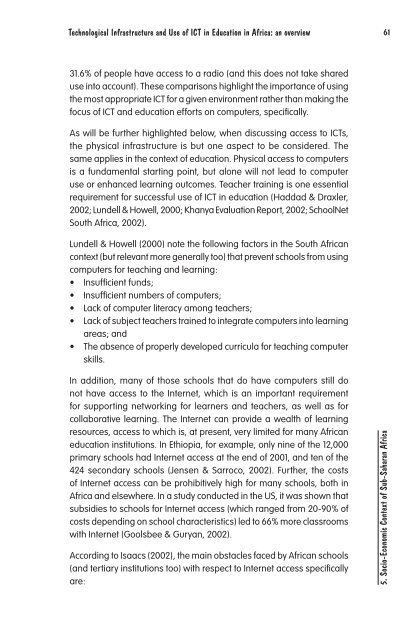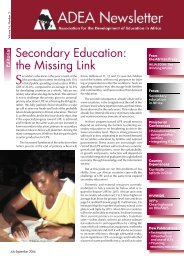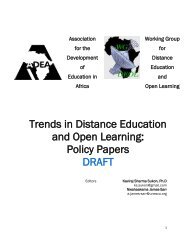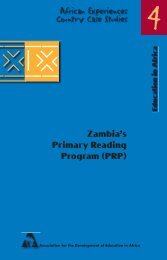Technological Infrastructure and Use of ICT in Education in ... - ADEA
Technological Infrastructure and Use of ICT in Education in ... - ADEA
Technological Infrastructure and Use of ICT in Education in ... - ADEA
Create successful ePaper yourself
Turn your PDF publications into a flip-book with our unique Google optimized e-Paper software.
<strong>Technological</strong> <strong>Infrastructure</strong> <strong>and</strong> <strong>Use</strong> <strong>of</strong> <strong>ICT</strong> <strong>in</strong> <strong>Education</strong> <strong>in</strong> Africa: an overview<br />
61<br />
31.6% <strong>of</strong> people have access to a radio (<strong>and</strong> this does not take shared<br />
use <strong>in</strong>to account). These comparisons highlight the importance <strong>of</strong> us<strong>in</strong>g<br />
the most appropriate <strong>ICT</strong> for a given environment rather than mak<strong>in</strong>g the<br />
focus <strong>of</strong> <strong>ICT</strong> <strong>and</strong> education efforts on computers, specifically.<br />
As will be further highlighted below, when discuss<strong>in</strong>g access to <strong>ICT</strong>s,<br />
the physical <strong>in</strong>frastructure is but one aspect to be considered. The<br />
same applies <strong>in</strong> the context <strong>of</strong> education. Physical access to computers<br />
is a fundamental start<strong>in</strong>g po<strong>in</strong>t, but alone will not lead to computer<br />
use or enhanced learn<strong>in</strong>g outcomes. Teacher tra<strong>in</strong><strong>in</strong>g is one essential<br />
requirement for successful use <strong>of</strong> <strong>ICT</strong> <strong>in</strong> education (Haddad & Draxler,<br />
2002; Lundell & Howell, 2000; Khanya Evaluation Report, 2002; SchoolNet<br />
South Africa, 2002).<br />
Lundell & Howell (2000) note the follow<strong>in</strong>g factors <strong>in</strong> the South African<br />
context (but relevant more generally too) that prevent schools from us<strong>in</strong>g<br />
computers for teach<strong>in</strong>g <strong>and</strong> learn<strong>in</strong>g:<br />
• Insufficient funds;<br />
• Insufficient numbers <strong>of</strong> computers;<br />
• Lack <strong>of</strong> computer literacy among teachers;<br />
• Lack <strong>of</strong> subject teachers tra<strong>in</strong>ed to <strong>in</strong>tegrate computers <strong>in</strong>to learn<strong>in</strong>g<br />
areas; <strong>and</strong><br />
• The absence <strong>of</strong> properly developed curricula for teach<strong>in</strong>g computer<br />
skills.<br />
In addition, many <strong>of</strong> those schools that do have computers still do<br />
not have access to the Internet, which is an important requirement<br />
for support<strong>in</strong>g network<strong>in</strong>g for learners <strong>and</strong> teachers, as well as for<br />
collaborative learn<strong>in</strong>g. The Internet can provide a wealth <strong>of</strong> learn<strong>in</strong>g<br />
resources, access to which is, at present, very limited for many African<br />
education <strong>in</strong>stitutions. In Ethiopia, for example, only n<strong>in</strong>e <strong>of</strong> the 12,000<br />
primary schools had Internet access at the end <strong>of</strong> 2001, <strong>and</strong> ten <strong>of</strong> the<br />
424 secondary schools (Jensen & Sarroco, 2002). Further, the costs<br />
<strong>of</strong> Internet access can be prohibitively high for many schools, both <strong>in</strong><br />
Africa <strong>and</strong> elsewhere. In a study conducted <strong>in</strong> the US, it was shown that<br />
subsidies to schools for Internet access (which ranged from 20-90% <strong>of</strong><br />
costs depend<strong>in</strong>g on school characteristics) led to 66% more classrooms<br />
with Internet (Goolsbee & Guryan, 2002).<br />
Accord<strong>in</strong>g to Isaacs (2002), the ma<strong>in</strong> obstacles faced by African schools<br />
(<strong>and</strong> tertiary <strong>in</strong>stitutions too) with respect to Internet access specifically<br />
are:<br />
5. Socio-Economic Context <strong>of</strong> Sub-Saharan Africa

















